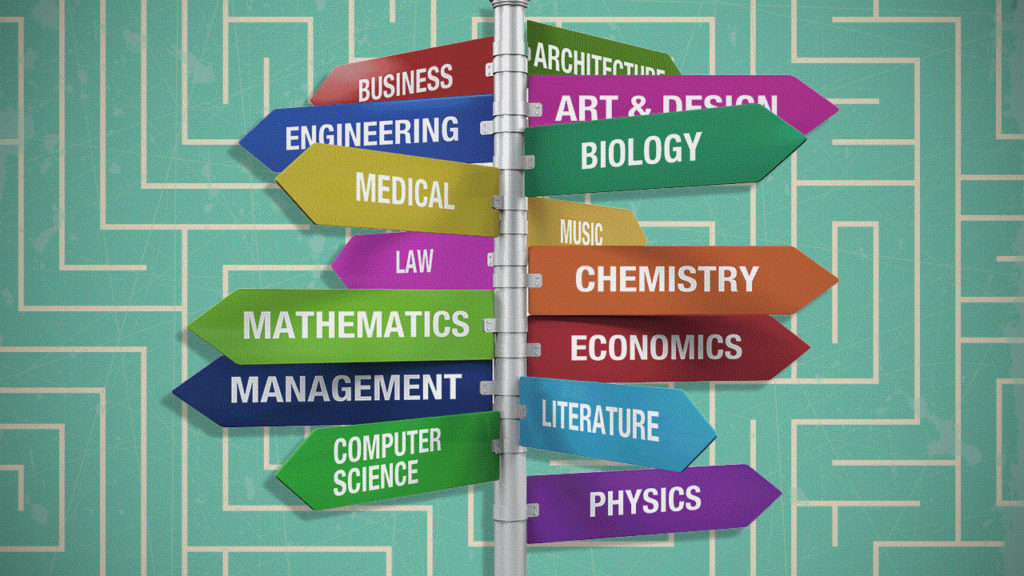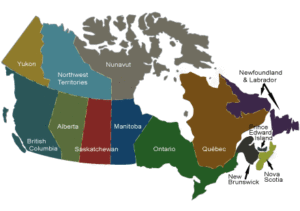2017 archive
It’s Not Just About Getting In 0
 Some students go to college knowing exactly what they want to do. But most don’t. At large state universities, it is not uncommon that over 75% percent of freshmen, even those who have declared a major, say they are uncertain about their major, and half will change their minds after they declare, sometimes more than once. That is one big reason that only 37% of students graduate in four years.
Some students go to college knowing exactly what they want to do. But most don’t. At large state universities, it is not uncommon that over 75% percent of freshmen, even those who have declared a major, say they are uncertain about their major, and half will change their minds after they declare, sometimes more than once. That is one big reason that only 37% of students graduate in four years.
Colleges and universities have vested interests in students declaring early. Retention rates for declared students are better, and they are more likely to graduate in four years. But college officials also recognize that deciding on a major can be overwhelming, especially when coupled with the fear that a wrong choice will result in added semesters and tuition. Especially when coupled with the fear that a wrong choice will result in added semesters and tuition. Students no longer have the luxury of stumbling into a major or making mistakes, not that they ever did.
This requires thinking ahead. Teenagers are not expected to know what to do with the rest of their lives at age 18,  but with coaching, they can cover the bases with prudent planning. Some majors have a curriculum that follows a tight sequence of courses. It’s easier to switch out of engineering than it is to take it up later in the college career.
but with coaching, they can cover the bases with prudent planning. Some majors have a curriculum that follows a tight sequence of courses. It’s easier to switch out of engineering than it is to take it up later in the college career.
The biggest mistake students make is failing to research what’s required of the major, and the profession. Nursing may sound attractive because a student wants to help people, but nursing students take the same demanding math and science curriculum as premed students, and the work is often technical and not for every kindhearted soul. It is also a similar track with Physical Therapy.
More niche filling additions to the list obviously reflect marketplace trends and student demand, like culinary science/culinology, digital arts, and sports communication. At Montclair State University in New Jersey, which offers 300 majors, minors and concentrations, new fashion studies major has been hugely popular, thanks to the university’s proximity to Manhattan; with Madison Square Garden and Giants Stadium in sight. It also guides the ambitious undergrad toward internship opportunities in a sports industry and event-planning major within its business school.
 Still, it’s difficult to predict the employment market. That is why I will encourage students to think outside the box. In other words, if the job doesn’t exist…create one. Many students choose majors they think will lead to jobs, but four years from now freshmen will be applying for jobs that don’t even exist today.
Still, it’s difficult to predict the employment market. That is why I will encourage students to think outside the box. In other words, if the job doesn’t exist…create one. Many students choose majors they think will lead to jobs, but four years from now freshmen will be applying for jobs that don’t even exist today.
Most employers are looking for transferable skills the ability to problem solve, work collaboratively, write and speak clearly and think critically. These can be developed in any liberal arts discipline. It makes no sense to suffer through a major because you think it will lead to employment.
In the final analysis, wherever a teenager goes and does after high school, which I call Crossing the Gap Preparing for the Transition, where they go does not matter as much as what they do when they got there.
The late great business philosopher, Jim Rohn, said this “A formal education will make you a living, but self-education will make you a fortune!” These two college graduates understood that. You can too! 1 (978) 820-1295
The Canadian Option 0
The Canadian Option
 In recent years, I have written about extraordinary colleges that students know little or nothing about, but should. All but one of those colleges are in the United States. Now I want to discuss higher education opportunities that are north of the border. Have you ever considered the Canadian option? Why not?
In recent years, I have written about extraordinary colleges that students know little or nothing about, but should. All but one of those colleges are in the United States. Now I want to discuss higher education opportunities that are north of the border. Have you ever considered the Canadian option? Why not?
Here are a few reasons why you may want to:
- The quality of education and living standards in Canada are amongst the highest in the world, but the cost of living and tuition fees are generally lower than comparable college costs in the United States. At the time of this writing, $1.00 US equals $1.33 CA. Therefore, the University of Toronto’s cost of attendance (COA) for non-residents is $46,530 (CA) but $35,363 (US). A comparable American university is $65,750. Most of the Canadian universities accept the US Federal loan programs, including the PLUS loan. But they do not accept US Pell or SEOG grants. From an affordability standpoint, this could make the Canadian option impractical because there is little need-based grant aid given to American students to fill the gap.
- There are around 100 major universities in Canada and 95% are publicly supported. There is a high level of respect given to secondary school teachers across the provinces and most students take their lessons seriously and some observers believe they are better prepared for college than their American counterparts. This translates
 into a positive peer environment for the mature teenager from the US who is going to college, not because it is the thing to do but to pursue an academic concentration that will prepare them for life beyond college. Learning does not stop after the degree is earned. It is a lifelong activity.
into a positive peer environment for the mature teenager from the US who is going to college, not because it is the thing to do but to pursue an academic concentration that will prepare them for life beyond college. Learning does not stop after the degree is earned. It is a lifelong activity.
- Canada’s high academic standards and rigorous quality controls mean that there is more likelihood of earning a high-quality education that will open doors for your future and benefit your career over the long term. You want to be prepared. A Canadian degree, diploma, or certificate is globally recognized as being equivalent to those obtained from the United States. There are also more CO-OP programs offered than in the US as well as accelerated three-year Bachelors’s degree options. (Keep in mind, however, that if a US graduate degree is pursued, the 3-year degree may not satisfy requirements for some US graduate programs.) Here is the latest ranking of the top Canadian colleges and universities. Now, settle back; grab a hot chocolate and take a virtual tour of them all.
- Study abroad opportunities abound in US colleges. I encourage students to take a semester in another country if it includes taking classes in a university while there. But how about all four years in the foreign country above instead of abroad? With almost all of the world’s ethnic groups represented in Canada, it’s hard not to find ethnic foods and recreation activities associated with specific cultures. Canada has long had a welcome mat out to immigrants from other cultures. They have excellent

screening procedures, but there is little of the fear of “aliens that has been instilled into the US population.
- You may have heard of or experienced Canadians friendly and open nature. During all my visits to Canada, I experienced that friendliness. In fact, the United Nations consistently ranks Canada as one of the best places in the world to live. As an international student in Canada, you’ll enjoy all of the same freedoms which protect Canadians, respect for human rights, equality, and a stable and peaceful society.
By now you may be asking “This looks great but what are my chances of getting in and how complex is the application process?”
Each university has its own application but it is much more straightforward than the Common Application, which only three private schools in Canada accept, by the way. You will need to do your AAA due diligence as you should be doing already. Keep in mind, however, that the admissions person you would have contact with is the International Counselor, not a regional counselor that you will find in private American schools.
Dan Seneker, Student Recruitment Manager at the University of Saskatchewan list the application steps here. Plus a plethora of information and eye-opening statistics here. Finally, here is a link that encapsulates the differences between American and Canadian universities.
Trends Are Watched 0
We Saw Them Coming
At a seminar for college admissions advisers I attended in 1995, Don Bishop who is currently Associate VP of Undergraduate Enrollment at Notre Dame, made some very interesting and accurate observations. One of the important tasks of an Enrollment Manager on a college campus is to look at short term and long term trends in population growth.
Mr. Bishop observed that the year 1999 would be the last year a bright high school graduate could assemble a list of six competitive colleges and be reasonably assured of acceptance somewhere, if not at his first choice, at least at the flagship university in his or her state of residence.
The rapidly increasing birth rate beginning in 1982 (ubiquitous baby boomers being the culprits, once again) have put increasing pressure on the college admission offices. Since the year 2000, the number of college-bound high school seniors has steadily increased each year. In fact, the graduation year 2014 was the largest high school graduating class in American history!
To compound the challenge is the fact the government, particularly the SEC, Congress and the private Federal Reserve have demonstrated a collective lack of oversight and/or fiscal malfeasance. This has further corrupted the fiat credit system that our nation’s economy is based on. The negative impact on family savings and investments has forced more students to look at not just their state universities and colleges but their community colleges. But even these lower cost institutions may not accommodate all of the students applying in the coming years.
The New York Times article points out across the country, many community colleges have felt similar pressures. The battered economy drove many workers back to school to retool their skills, while others have eschewed a four-year degree in favor of a more affordable two-year program.
Therefore, much more deliberate and practical planning will need to be done as a family. Post secondary school planning with us begins with a get acquainted FREE consultation. For more information contact us here.
